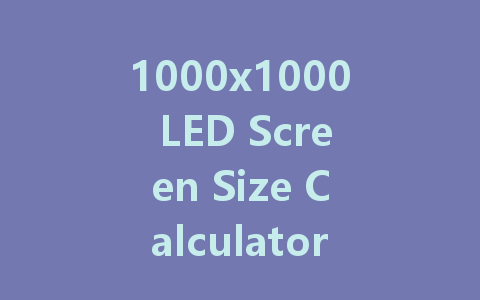
When it comes to creating visual displays, choosing the right LED screen size is crucial. Whether you’re setting up a stunning backdrop for a concert, displaying advertisements, or augmenting an interactive experience, understanding how to calculate the ideal screen size can make all the difference. In this article, we’ll explore how to use a 1000×1000 LED screen size calculator and provide you with practical insights on selecting the perfect dimensions for your needs.
Understanding LED Screen Sizes
LED screens are available in a variety of sizes, measured in pixels and physical dimensions. Commonly, screens are identified by their pixel density, resolution, and overall size. The term “1000×1000” refers to the number of pixels across the width and height of the screen. Here’s why this matters:
Benefits of Using a Size Calculator
Using an LED screen size calculator offers several advantages:
Accuracy
These calculators eliminate guesswork. By inputting specific parameters, such as the viewing distance and intended use, you can obtain precise measurements that cater to your requirements.
Customization
Every project is unique. Whether you’re working in a stadium, a conference room, or an outdoor event, a size calculator helps you customize the screen dimensions based on your specific context.
Budget Consideration
Knowing the appropriate size can also aid in budgeting. A larger screen might be ideal for a big crowd but may come with increased costs. A calculator allows you to weigh those costs against your visual needs effectively.
How to Use the 1000×1000 LED Screen Size Calculator
Using a size calculator is straightforward. Here’s a simple step-by-step guide:
Factors to Consider When Choosing Screen Size
Beyond just using a calculator, several factors can influence your decision on the ideal LED screen size:
Purpose of the Screen
Are you showcasing promotional content, broadcasting live events, or facilitating presentations? Each purpose may require a different screen size for optimal visibility.
Venue Size
The physical dimensions of the venue matter greatly. A small venue may not need a massive screen, while a large stadium requires a more prominent display for better visibility from afar.
Audience Engagement
Think about how close your audience will be to the screen. If they’ll be within a few feet, a larger resolution with higher pixel density will enhance their experience.
Environment
Lastly, consider environmental factors such as lighting conditions. Outdoor settings, for example, may require brighter screens compared to indoor venues due to ambient light impact.
Real-world Applications of LED Screen Calculators
The versatility of 1000×1000 LED screens and the use of size calculators can be seen across multiple industries:
Event Productions
From concerts to trade shows, event planners rely on size calculators to ensure that screens are visible and impactful from various angles.
Advertising
In retail, size calculators aid businesses in deciding which screen sizes will best capture customer attention. A well-sized screen can drastically improve viewer engagement.
Corporate Presentations
Businesses hosting large meetings can benefit from calculated screen sizes. The resolution and visibility of information become paramount in promoting effective communication.
Conclusion
Finding the perfect size for your LED screen is essential for achieving a successful visual display. With tools like the 1000×1000 LED screen size calculator, you can accurately measure your needs based on viewing distance, environment, and purpose.
By considering the various factors and customizing your approach, you can ensure that your audience enjoys an engaging and visually stunning experience. The right screen size not only enhances the quality of your presentation but also makes a lasting impression on your viewers. So, whether you’re organizing an event, promoting a product, or hosting a business presentation, leverage the power of a size calculator to bring your vision to life.